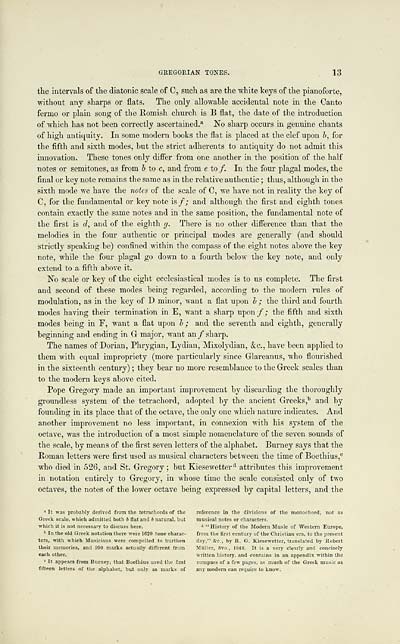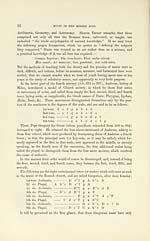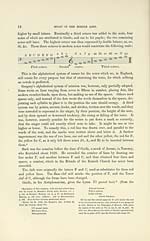Glen Collection of printed music > Printed text > Popular music of the olden time > Volume 1
(47) Page 13
Download files
Complete book:
Individual page:
Thumbnail gallery: Grid view | List view

GREGORIAN TONES. 13
the intervals of the diatonic scale of 0, such as are the white keys of the pianoforte,
■without any sharps or flats. The only allowable accidental note in the Canto
fermo or plain song of the Romish church is B flat, the date of the introduction
of which has not been correctly ascertained.'' No sharp occurs in genuine chants
of high antiquity. In some modern books the flat is placed at the clef upon h, for
the fifth and sixth modes, but the strict adherents to antiquity do not admit this
innovation. These tones only difi"er from one another in the position of the half
notes or semitones, as from h to c, and from e to/. In the four plagal modes, the
final or key note remains the same as in the relative authentic ; thus, although in the
sixth mode we have the notes of the scale of C, we have not in reality the key of
C, for the fundamental or key note is/; and although the first and eighth tones
contain exactly the same notes and in the same position, the fundamental note of
the first is d, and of the eighth g. There is no other difference than that the
melodies in the four authentic or principal modes are generally (and should
strictly speaking be) confined within the compass of the eight notes above the key
note, while the four plagal go down to a fourth below the key note, and only
extend to a fifth above it.
No scale or key of the eight ecclesiastical modes is to us complete. The first
and second of these modes being regarded, according to the modern rules of
modulation, as in the key of D minor, want a flat upon h ; the third and fourth
modes having their termination in E, want a sharp upon/; the fifth and sixth
modes being in F, want a flat upon h ; and the seventh and eighth, generally
beginning and ending in G major, want an /sharp.
The names of Dorian, Phrygian, Lydian, Mixolydian, &c., have been applied to
them with equal impropriety (more particularly since Glareanus, who floiu'ished
in the sixteenth century) ; they bear no more resemblance to the Greek scales than
to the modern keys above cited.
Pope Gregory made an important improvement by discarding the thoroughly
groundless system of the tetrachord, adopted by the ancient Greeks,'' and by
founding in its place that of the octave, the only one which nature indicates. And
another improvement no less important, in connexion with his system of the
octave, was the introduction of a most simple nomenclature of the seven sounds of
the scale, by means of the first seven letters of the alphabet. Burney says that the
Roman letters were first used as musical characters between the time of Boethius,"
who died in 526, and St. Gregory ; but Kiesewetter'^ attributes this improvement
in notation entirely to Gregory, in whose time the scale consisted only of two
octaves, the notes of the lower octave being expressed by capital letters, and the
" It was probably derived from the tetrachords of the reference in the divisions of the monochord, not as
Greek scale, which admitted both b flat and b natural, but musical notes or characters,
which it is not necessary to discuss here. ^ " History of the Modern Music of Western Europe,
^ In the old Greek notation there were 1620 tone charac- from the first century of the Christian era, to the present
ters, with which Musicians were compelled to burthen day," &c., by K. G. Kiesewetter, translated by Robert
their memories, and 990 marks actually different from Miiller, 8vo., 1848. It is a very clearly and concisely
each other. written history, and contains in an appendix within the
^ It appears from Burney, that Boethius used the first compass of a few pages, as much of the Greek music as
fifteen letters of the alphabet, but only as marks of any modem can require to know.
the intervals of the diatonic scale of 0, such as are the white keys of the pianoforte,
■without any sharps or flats. The only allowable accidental note in the Canto
fermo or plain song of the Romish church is B flat, the date of the introduction
of which has not been correctly ascertained.'' No sharp occurs in genuine chants
of high antiquity. In some modern books the flat is placed at the clef upon h, for
the fifth and sixth modes, but the strict adherents to antiquity do not admit this
innovation. These tones only difi"er from one another in the position of the half
notes or semitones, as from h to c, and from e to/. In the four plagal modes, the
final or key note remains the same as in the relative authentic ; thus, although in the
sixth mode we have the notes of the scale of C, we have not in reality the key of
C, for the fundamental or key note is/; and although the first and eighth tones
contain exactly the same notes and in the same position, the fundamental note of
the first is d, and of the eighth g. There is no other difference than that the
melodies in the four authentic or principal modes are generally (and should
strictly speaking be) confined within the compass of the eight notes above the key
note, while the four plagal go down to a fourth below the key note, and only
extend to a fifth above it.
No scale or key of the eight ecclesiastical modes is to us complete. The first
and second of these modes being regarded, according to the modern rules of
modulation, as in the key of D minor, want a flat upon h ; the third and fourth
modes having their termination in E, want a sharp upon/; the fifth and sixth
modes being in F, want a flat upon h ; and the seventh and eighth, generally
beginning and ending in G major, want an /sharp.
The names of Dorian, Phrygian, Lydian, Mixolydian, &c., have been applied to
them with equal impropriety (more particularly since Glareanus, who floiu'ished
in the sixteenth century) ; they bear no more resemblance to the Greek scales than
to the modern keys above cited.
Pope Gregory made an important improvement by discarding the thoroughly
groundless system of the tetrachord, adopted by the ancient Greeks,'' and by
founding in its place that of the octave, the only one which nature indicates. And
another improvement no less important, in connexion with his system of the
octave, was the introduction of a most simple nomenclature of the seven sounds of
the scale, by means of the first seven letters of the alphabet. Burney says that the
Roman letters were first used as musical characters between the time of Boethius,"
who died in 526, and St. Gregory ; but Kiesewetter'^ attributes this improvement
in notation entirely to Gregory, in whose time the scale consisted only of two
octaves, the notes of the lower octave being expressed by capital letters, and the
" It was probably derived from the tetrachords of the reference in the divisions of the monochord, not as
Greek scale, which admitted both b flat and b natural, but musical notes or characters,
which it is not necessary to discuss here. ^ " History of the Modern Music of Western Europe,
^ In the old Greek notation there were 1620 tone charac- from the first century of the Christian era, to the present
ters, with which Musicians were compelled to burthen day," &c., by K. G. Kiesewetter, translated by Robert
their memories, and 990 marks actually different from Miiller, 8vo., 1848. It is a very clearly and concisely
each other. written history, and contains in an appendix within the
^ It appears from Burney, that Boethius used the first compass of a few pages, as much of the Greek music as
fifteen letters of the alphabet, but only as marks of any modem can require to know.
Set display mode to: Large image | Transcription
Images and transcriptions on this page, including medium image downloads, may be used under the Creative Commons Attribution 4.0 International Licence unless otherwise stated. ![]()
| Special collections of printed music > Glen Collection of printed music > Printed text > Popular music of the olden time > Volume 1 > (47) Page 13 |
|---|
| Permanent URL | https://digital.nls.uk/91368011 |
|---|
| Shelfmark | Glen.254 |
|---|---|
| Additional NLS resources: | |
| Attribution and copyright: |
|
| Description | Scottish songs and music of the 18th and early 19th centuries, including music for the Highland bagpipe. These are selected items from the collection of John Glen (1833 to 1904). Also includes a few manuscripts, some treatises, and other books on the subject. |
|---|
| Description | The Glen Collection and the Inglis Collection represent mainly 18th and 19th century Scottish music, including Scottish songs. The collections of Berlioz and Verdi collected by bibliographer Cecil Hopkinson contain contemporary and later editions of the works of the two composers Berlioz and Verdi. |
|---|

